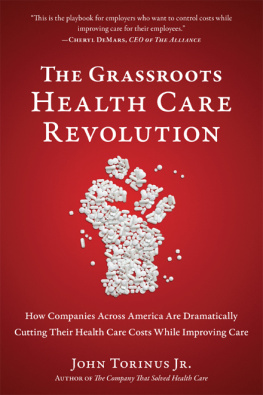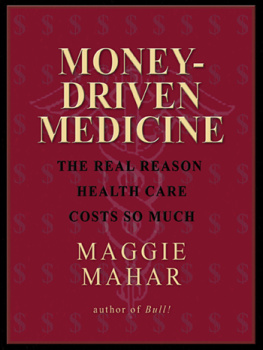Contents
Guide
Page List
THE LONG FIX
Solving Americas Health
Care Crisis with Strategies
That Work for Everyone
VIVIAN S. LEE, MD

The Long Fix is a work of nonfiction. Certain names have been changed.
Copyright 2020 by Vivian S. Lee
All rights reserved
First Edition
For information about permission to reproduce selections from this book, write to Permissions, W. W. Norton & Company, Inc., 500 Fifth Avenue, New York, NY 10110
For information about special discounts for bulk purchases, please contact W. W. Norton Special Sales at specialsales@wwnorton.com or 800-233-4830
Jacket design by Pete Garceau
Book design by Dana Sloan
Production manager: Anna Oler
The Library of Congress has cataloged the printed edition as follows:
Names: Lee, Vivian S., 1966 author.
Title: The long fix : solving Americas health care crisis with strategies that work for everyone / Vivian S. Lee.
Description: First edition. | New York, N.Y. : W.W. Norton & Company, [2020] | Includes bibliographical references and index.
Identifiers: LCCN 2020009618 | ISBN 9781324006671 (hardcover) | ISBN 9781324006688 (epub)
Subjects: MESH: Health Care Costs | Health Care Reform | Quality of Health Care | Delivery of Health Careeconomics | United States
Classification: LCC RA971.3 | NLM W 74 AA1 | DDC 362.1068/1dc23
LC record available at https://lccn.loc.gov/2020009618
W. W. Norton & Company, Inc., 500 Fifth Avenue, New York, N.Y. 10110
www.wwnorton.com
W. W. Norton & Company Ltd., 15 Carlisle Street, London W1D 3BS
To my parents, Sam and Elisa Lee, and to my sister, Jennifer
Lee, who have devoted their lives to improving the health of our
communities through research, teaching, and innovation.
To my lifelong partner, Benedict Kingsbury, and to our four
daughters, who bring immeasurable joy to our lives.
CONTENTS
It was the best of times, it was the worst of times, it was the age of wisdom, it was the age of foolishness, it was the epoch of belief, it was the epoch of incredulity...
Charles Dickens, A Tale of Two Cities
T he rumbling engine of the wood-paneled station wagon cut through the scorching Oklahoma summer heat as it pulled over to the curb. The radio, tuned as always to the local country station, blared Loretta Lynns latest hit. As I slipped into the front seat, Hal Belknap leaned forward in the drivers seat to turn it down and shot me an apologetic look, as he always did.
Dr. Belknapwe all called him Dr. Bwas a prominent internal medicine doctor in Norman, Oklahoma. In 1979, he had volunteered for a program that matched junior high students with community leaders, and I got lucky. For the next few years, I spent my Saturday mornings at Norman Regional Hospital, tagging along as he made his rounds and feeling rather like an extra on Marcus Welby, M.D., that popular TV show from the 1970s.
On a typical morning, we would set out to find Mabel, Fred, Hank, Rosetta, and the other patients propped up in their hospital beds, eagerly awaiting us. (Well, mostly eagerly awaiting Dr. B.) After swinging their breakfast trays to the sidecareful not to spill the small cartons of milk and bowls of cereal and canned fruit medleyDr. B would sit on the side of their beds and listen to their hearts, their lungs, and their stories. He was always deeply attentive to their medical ailments, but he also wanted to find out what was on their minds. I could see him making mental notes as he asked after their families: the granddaughters wedding (note: have Vickihis nursesend a card), the husband who had just been discharged from the hospital (note: set up home nursing visits), and the son who was moving back home (note: invite grandson to join Dr. Bs Boy Scout troop).
After completing rounds, Dr. B scrawled his practically indecipherable notes in their charts, gave instructions to the nurses, and occasionally ordered a study or lab test. A naturally sharp diagnostician, he didnt request many studies or interventions, relying mostly on his intuition and judgment. He placed the most weight on what was best for the patient and often reminded me that less was more, even in medicine.
Caring for patients back then was less complicated, less bureaucratic, less expensive. Dr. B and his colleagues kept all their medical records on paper and carried tone-only pagers (no screens). CT (computed tomography, or CAT) scans were new, and MRI (magnetic resonance imaging)my future specialtyhad not yet come into the picture. Drug prices were reasonable and rarely made the news. But not everything was better when it was simpler. Most patients who had strokes and heart attacks died or were debilitated by them. We hadnt imagined gene therapies or robotic surgeries or electronic medical records. I also never heard the words health care reform.
I decided back then that I wanted to be a doctor. I was certain that Dr. B had improved the lives of his patients and that it was rewarding for him, too. I set off in pursuit of this noble profession with a determined optimism.
The Journey to MD and CEO
Fifteen years laterafter college, graduate school, medical school, a surgical internship, radiology residency, and a fellowship in MRII emerged in 1998 ready for my first real job (Finally! my parents said). In the two decades since I had accompanied Dr. B, medicine had changed dramatically. For one, my fieldmagnetic resonance imaginghad been invented. MRI radiologists were spotting small cancers early enough to save patients lives and sparing others from the poking and prodding of procedures such as angiograms, cholangiograms, and fistulograms. New medications like clot-busting drugs were saving patients with heart attacks and strokes. And deaths due to cancer were finally starting to decline, thanks to better prevention and new chemotherapies. As a researcher and later, as chief scientific officer at NYU Langone Medical Center in New York, I could see that the discoveries coming out of research laboratoriesgenomics, stem cell therapy, immunotherapy, the microbiome, and morewere offering new hope for many, even the possibility of curing the incurable.
At the same time, health care was also showing signs of changing for the worse. Doctoring involved a lot more negotiating with insurance companies than sitting at the bedside or thinking through hard-to-diagnose conditions. A series of widely cited reports from the Institute of Medicine (now the National Academy of Medicine) cast a deeply critical eye on safety and quality in the American health system. All the while, health costs were increasing so rapidly that it became clear that if we didnt reduce the costs of care and get our system back on track, all those scientific advances might be for naught.
These realizations were weighing heavily on me when I made a visit to Boston in 2010 that changed the trajectory of my career. I went to see an old friend of mine, Gregg Meyer, an internal medicine physician who at the time was the senior vice president for quality and safety at the Massachusetts General Hospital. I was there to learn about research administration from a hospital famous for its scientific excellence.
While there, Gregg introduced me to their sophisticated electronic health records system. He told me how it was completely changing the way his hospital was approaching care. When patients turned 50, for example, the computers automatically offered them a pamphlet or DVD (the latest technology then) that explained why they should undergo a colonoscopy to screen for colon cancer. No more relying on doctors to remember. For each doctor, the computer system also tracked which of their patients with high blood pressure were getting better with treatment and which needed more attention.






